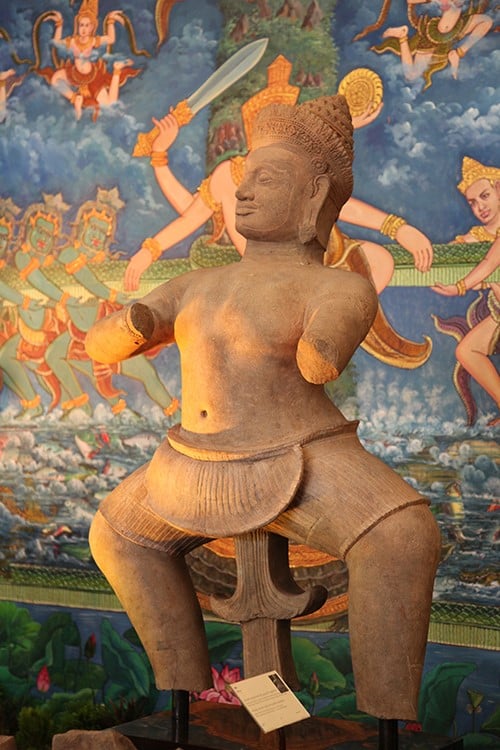Market
Opinion: It’s Time to Stop Profiting from the Killing Fields
The return of five sandstone warriors to Cambodia last month was well overdue.

The return of five sandstone warriors to Cambodia last month was well overdue.

Pierre Ciric, Tess Davis, Max Howlett, Matthew Rendall, and Sun Samnang

On October 1, Cambodia celebrated the return of five sandstone warriors, marking the end of their decades-long journey from a jungle war zone to the international art market. These mythological figures have now found a permanent home at the National Museum in the riverfront capital of Phnom Penh. However, for a millennium, they had guarded the ancient capital of Koh Ker, until the chaos heralding the killing fields, when they fell victim to looters. This past summer, Christie’s Auction House and the Norton Simon Museum returned two, while Cambodia recovered another from Sotheby’s following 20 months of contentious litigation. This trio is now displayed with a pair previously repatriated by the Metropolitan Museum of Art in 2013.
In contrast to Christie’s and the Metropolitan—which acted without protest once discovering their statues’ troubled histories—the Norton Simon and Sotheby’s long fought these restitutions. Even as Cambodia enjoyed its homecoming celebrations last June, as monks blessed the figures with jasmine garlands, halfway around the world in the US, both institutions continued to fight. They repeatedly mischaracterized the returns as generous acts of goodwill, not legal obligations. In the media the Norton Simon dismissed Cambodia’s patrimony laws as “ambiguous at best,” while in court pleadings Sotheby’s wrongly claimed such codes were only enacted decades after the statues’ theft. This is simply not true.
An entire legal regime undeniably provided for these statues’ protection, and, moreover, designated them state property beginning at the time when they were carved. This is not just the authors’ opinion, but also that of the Cambodian, French, and US governments.
Under Cambodian law, prior to the 1863 French “Protectorate,” the King owned all land, including archaeological sites and antiquities. The colonial era then brought with it French administration and law, including a legal protection framework for cultural heritage that dates back to the 19th century and still reaches throughout the francophone world. This was not just a system on paper, but one vigorously enforced, as evidenced when “l’Affaire Malraux” made international headlines in the 1920s.

Photo: US Embassy Phnom Penh.
Young Frenchman André Malraux—who later became an award-winning author and minister of culture—was then arrested and prosecuted for plundering Cambodian ruins. During his well-publicized trial, Malraux argued the country’s laws were ambiguous, and thus, its ancient sites lacked any owner (a rhetoric echoed by Sotheby’s and the Norton Simon). But this defense failed twice in Indochina’s courts, which convicted Malraux and further ordered the restitution of the pieces to their rightful owner—the Cambodian state.
By Cambodia’s 1953 independence, the colonial administration had fleshed out this existing framework with a further series of laws, clearly and unambiguously declaring that ancient sites and objects were state property. These codes, decrees, and orders established antiquities could only end up in private hands through formal, documented transfers (which never took place for the Koh Ker statues).
But in 1970, Cambodia erupted into civil war with the Khmer Rouge. According to US court filings, art thieves and smugglers took advantage of the conflict, looting Koh Ker around 1972. Its masterpieces were trafficked as parts to Thailand, where they entered the international market, with the so-called Sotheby’s statue landing on a London auction block in 1975. That same year, Phnom Penh fell, and it was the beginning of the “killing fields,” in which one in four Cambodians would die of murder, disease, or starvation.
It is not surprising these statues have now been returned to Cambodia, but that more have not followed. It is morally abhorrent that some museums, dealers, and collectors continue to profit from the killing fields.
It is also illegal.
Cambodian ownership laws have always been clear and unambiguous, and likewise, they have always been enforced to the best of the country’s ability. As the capitulation in the Sotheby’s case reveals, there are now no moral or legal grounds to deny the Kingdom of Cambodia and its people the rightful restitution of their national patrimony.
Pierre Ciric is a French-American attorney based in New York specialized in cultural property law, most notably Nazi-looted art cases. Tess Davis is a New York attorney and an affiliate researcher at the Scottish Centre for Crime and Justice Research at the University of Glasgow; she is specialized in the pillage of ancient sites from Southeast Asia. Max Howlett is an international lawyer who was directly involved in the Duryodhana case against Sotheby’s. Matthew Rendall is an Australian national who has been working in the legal sector in Cambodia since 1994; he was an expert witness for the US Government in the Duryodhana case against Sotheby’s. Sun Samnang is a Cambodian attorney who worked on behalf of the US Government in its case against Sotheby’s for the return of the Duryodhana to Cambodia.